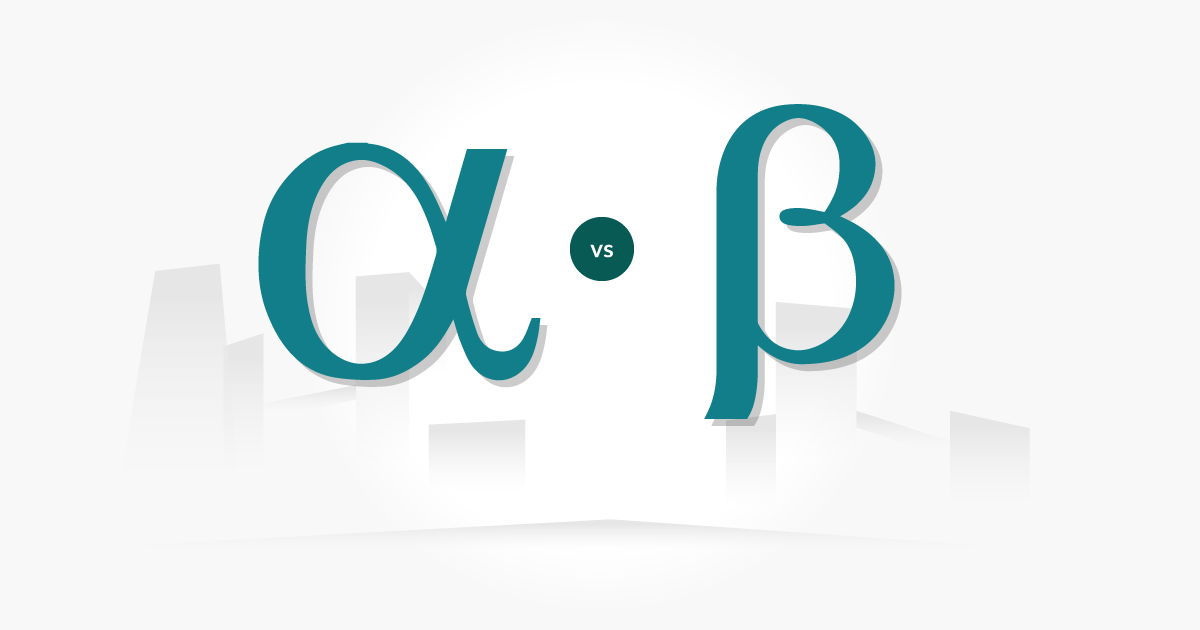Alpha vs Beta
Alpha vs Beta
By Katie Gomez

If you thought you would never have to deal with these greek letters after passing high school in algebra, think again. There is a long list of tools traders can use, but most are hard to comprehend. For instance, utilizing the old algebraic formulas of alpha and beta confuses people in how it relates to investing.
If this sounds like you, need not worry. I’m going to review the fundamental differences between alpha and beta and how to understand them relative to trading stocks, so you can start taking advantage of a new tool for your skillset.
First, I will state the significance of alpha and beta and explain how they differ. Alpha and beta are risk ratios that are calculated by investors and used as tools used to compare or predict returns. However, each of them serves different roles in the stock market.
What is Beta?
It is hard to understand alpha without learning beta first and its relation to investing. Beta, or the beta coefficient, is a historical number that measures volatility. The beta coefficient is a benchmark measuring the systemic risk of your portfolio risk compared to other indexes.
We demonstrate beta with a baseline number of 1, with a percentage value added to indicate how the price moves as the market changes. For example, if a stock has a baseline (1) and its beta value is 1.6, the stock value is 60% more volatile than the market. You must learn to read this data concerning your investments to see how the prices move with the market, helping decrease your risk.
That said, the value of beta means different things for different investors: a high beta is appealing to investors in growth stocks, but not if you are an investor seeking lower risk with steady returns. The calculation of beta is a simple two-step process:
- Divide the security stock’s standard deviation of returns by the benchmark’s standard deviation.
- Multiply the end value by the ‘correlation’ of the security’s returns and the benchmark’s.
For example, say you want to calculate the beta of Tesla and compare it to SPY. Once you look at the past data (approximately five years), you would find they have a covariance of 0.032 and the variance of SPY is .15. Once you have the data, all you have to do is plug it into the equation to solve for beta (just like algebra class).
Beta TSLA =0.032/0.015 = 2.13
Therefore, TSLA is theoretically 113% more volatile than SPY. Once you can calculate beta, you also must look at alpha to solve this equation.

What is Alpha?
Alpha is the measurement that lets investors know what stock consistently performs better than what beta predicted. Thinking back to high school algebra class: once finding the beta coefficient, you can now solve for alpha.
To clarify, alpha is historical data, so while you can establish a comparison with data shown over time, it cannot tell you how it will do tomorrow (a higher alpha value now is not implied in the future). Your benchmark must also have an aligned index (NASDAQ) instead of a more extensive market index (S&P 500) to avoid incorrect inflations of alpha value.
Although it indicates a percentage value, alpha will always display as a number. For example, relative to the benchmark index, if you see an alpha value of 3, that means your fund did 3% better, but if the number is -5, your stock did 5% worse than the benchmark. When the value of the alpha is more than zero, after adjusting for volatility, it means the investment outperformed the benchmark; so next time you hear hedge fund managers discuss high alpha, it means their managers have outperformed the market.
This basic equation formulates your expected rate of return: y = a + bx + u.
- y = the performance of the stock/fund.
- a = alpha or excess return of the stock/fund.
- b = beta or the volatility relative to the benchmark.
- x = the performance of the benchmark index.
- u = the residual or unexplained random performance in a year.
In conclusion, now that you know the significance of alpha and beta relative to the stock market, you can understand how to use these terms to improve your investment portfolio. Learning to use alpha and beta is yet another tool you can add to your belt to improve your current investment and trading skills, so why not take the time to learn?
The idea of finding alpha values is to discover how to get the highest possible return from your investment with the least amount of risk (improving your portfolio). On the other hand, when calculating the beta coefficient, you can determine how the stock is changing relative to the market. Alpha and beta are risk ratios, so they are significant to know, but you must calculate them carefully to avoid presenting false or inflated data.
References
https://www.thebalancemoney.com/alpha-vs-beta-for-investments-what-is-the-difference-5190249
